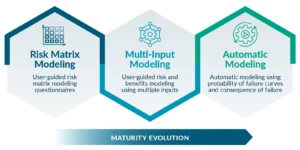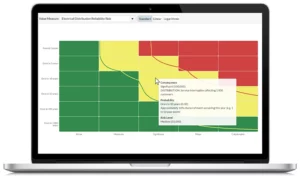How Much Data Do You Need for Asset Investment Planning?
When speaking to organizations about Copperleaf® and value-based decision making, it’s easy for people to recognize the transformative benefits of evolving their Asset Investment Planning (AIP) processes to accurately quantify the value of all projects. However, often the first question that comes up is: do we have enough data to feed the Copperleaf system?
The important thing to understand is that data will never be perfect. There will always be more data, or better data, that can be captured. However, don’t assume you can’t improve your decision-making because you don’t have perfect data or because you want to wait until you’ve implemented some other system. Your organization is already using the data you have to make decisions. That’s all you need to get started with Copperleaf. We help organizations use their data to improve the way they’re making asset investment decisions and create the highest-value plans.
Copperleaf’s value-based decision-making methodology supports organizations at all levels of maturity. Understanding these maturity stages also provides a roadmap to consider how to improve data quality to further improve decision making.
In this article, we’ll explore three stages of maturity and explain how Copperleaf helps clients at each stage use data to make more informed decisions—and continuously improve their investment planning processes over time.
Project Evaluation Maturity Stages
Assessing the value of projects is the area where organizations most commonly question whether they have the required type of data. The application of value-based decision making helps organizations identify the optimal portfolio of projects to execute and the best timing for every project—making it easier to communicate and defend plans to different stakeholders. This is one of the primary reasons why clients buy the Copperleaf solution, as it is frequently the area they struggle with the most.
Your organization is already capturing project benefits in some way—whether it’s quantitative for financial benefits or qualitative for risks and non-financial benefits. Copperleaf can use these existing inputs and work with you to develop a Value Framework to evaluate all the benefits of your projects on a common economic scale.
There are three different maturity stages organizations can progress through to evaluate a project’s value:

Project Evaluation Maturity Stages
Risk Matrix Modeling
Let’s start by going over the simplest method of quantifying risk: the risk matrix. With this approach, users are guided through a questionnaire and asked to select the consequence and probability levels from the risk matrix. Copperleaf helps clients align the probability and consequence levels for every risk type with the financial and non-financial benefits.
Each consequence and probability level will have a unique description, making it easy for users to select the right levels. For example, if you have an electric distribution asset that impacts 1,000 customers and expect it to fail about once in 10 years, you can use the risk matrix to select ‘significant’ as the consequence and a probability of ‘once in 10 years’, as shown below.

In addition to the risk matrix, the value framework can also include financial benefits (e.g. cost savings, increased revenue) and non-financial benefits models (e.g. environmental benefit, employee experience benefit). Copperleaf helps organizations assign a monetary value to all these different benefits, making it much easier to understand how different projects contribute to these areas.
Multi-Input Modeling
When organizations have additional data points they want to incorporate in project evaluation, multi-input modeling is the next stage of maturity. Rather than asking for a direct consequence and probability of failure from the risk matrix, you can include a series of questions that calculate a risk score for the project.
If we continue the previous example of an electric distribution asset, the series of questions could be:
- What type of customer is impacted? (e.g. residential, commercial, critical service)
- How long will customers be impacted?
- How many customers will be impacted? (e.g., how many households, commercial buildings, critical services, etc.)
- How many failures are expected to occur per year?
The responses to these questions will provide a more detailed assessment of the risk and value of this project than the risk matrix value model approach described earlier.
Automatic Modeling
Finally, the most mature and data-intensive method is automatic modeling because it requires information on how an asset behaves, such as “How will assets degrade over time?” and “How does the health or condition impact the probability of failure?”. If your organization has in-service dates for your assets, data to predict how assets will degrade as they age, and consequence of failure data, these inputs can be used to model the risk of each individual asset over time automatically.
Organizations can continue to mature in the automatic modeling stage by incorporating additional asset details to model the probability of failure more accurately. As an example, you may want to add information such as asset utilization, stop/start cycles, asset location, etc., to better predict how an asset has degraded and will degrade over time.
Getting Started
Many Copperleaf clients begin their journey at the first maturity level, with a risk matrix and simple models. While there are incremental benefits in adopting more mature levels of modeling, the greatest benefit comes from the initial implementation of Copperleaf’s value-based decision-making methodology. New clients can get started quickly by leveraging the Copperleaf Value Model Library, a constantly evolving collection of best practice models that have been validated by clients across multiple industries.
Again, the most important thing to emphasize is that all organizations already have the data to implement a value-based decision making approach. Over time, your organization will inevitably become more mature because this process will help you understand and prioritize the most important and valuable data to collect that supports decisions. It goes without saying that the most important thing is to get started early. Data will never be perfect. As we say at Copperleaf, “perfect is the enemy of great”!

